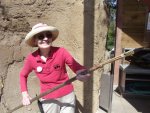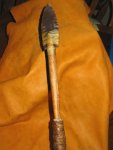Oh Really???In particular the moundbuilder culture liked to make these and even made some with spiders on them.
The Shaving Cadre
You are using an out of date browser. It may not display this or other websites correctly.
You should upgrade or use an alternative browser.
You should upgrade or use an alternative browser.
Mike's Flintknapping, Blacksmithing, & Primitive Crafts
- Thread starter Blade-meister
- Start date
That's super cool!One of the coolest museum projects was to make a replica Clovis spear for the San Diego Zoo's tar pit exhibit.
Dave in KY
Shave Newbie
I sense his 1st customer......Oh Really???
Oh Really???
Yes, it's a big spider that spans the face of the shell gorget. Very cool, but everyone always wants the rattlesnake effigies. Here's a typical example of the artifact (I did not make this one). I'm always amazed at the details the ancient ones captured in their simple depictions like this.
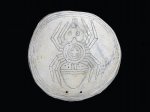
Cool Mike! Curious, how large are the gorgets?
About the size of a Coke can and smaller. I try to make them a size that could be worn if someone chooses. I can make them any diameter really, but I tend not to go smaller than 2.5 inches in diameter because the artwork gets too complicated the smaller it is.
Here's another grouping of shell and bone reproductions I made for the Western NY customer. The photo has them a bit more yellow than they were in real life. The middle guy is what is called a "September Morn" figure. They are extremely rare. The gorget on the left is a reproduction of a famous artifact and the one on the right is another rattlesnake gorget.
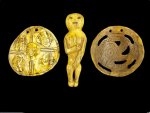

Another part of my hobby that I enjoy is making replica Indian pottery. I make several different types with a few different processes. Probably my specialty is the pottery I made that looks like it was just excavated from the ground. I've made more Susquehannock type pottery with effigy faces than any other type. I use all traditional tools to form the pottery including primitive cordage I made myself from dogbane plants. Here are some examples:
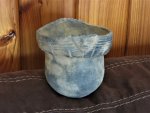
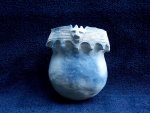
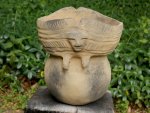
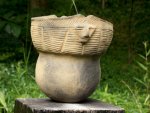
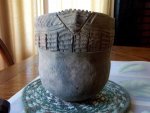
I also make a fair number of NY Owasco style pottery that are all based in design from real artifact pot shards I have in my collection.
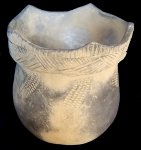
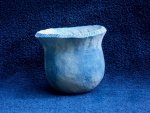
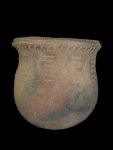
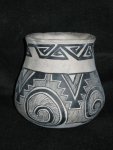





I also make a fair number of NY Owasco style pottery that are all based in design from real artifact pot shards I have in my collection.




Shy little guy there
It's actually a girl if you could have a different view
That last one is pretty neat! Do you go so far as to try and use the same materials and firing methods?
I use two different methods to make pottery. For the artifact replicas I use a self hardening clay so that I can have complete control over the process and a much longer working time. Since I custom color the pottery in the end to look super old, I don't really need a firing process. I also use the self hardening clay so that my customers will have a pot that will never crack on them or have several firings to get right.
The second method is completely like the Native Americans did in my area. I make the pottery out of clay that needs to be fired. I start with a warming fire in my fire pit and then place the dry pottery closer and closer to the coals until they are sitting right on the remnants of the warming fire. This drives out any last bits of moisture and prepares the pottery for firing. I then build a ring of hardwood and get a fire ring burning in the circle surrounding the pottery that was pre-warmed. I keep building and feeding the fire closer to the pottery in the center until I've completely covered the pottery. I then feed the fire for an hour, let it burn down to a pile of hot coals, and cover it up with an old drum from a dryer. I slide a stone over the hole in the top and then just let it be. After dinner on the same day I go up and see what survived. If a wind suddenly appears I will lose quite a few pots and if a sudden rain storm shows up I will lose all of the pottery most likely so I have to be 100% sure of a hot, dry, calm day. Here are some examples of things I've fired the traditional way as I just described:
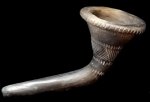
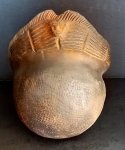

Here's some of my mini pots that are about the size of a shot glass. Kids love to buy them at my shows and adults love them to put on their desks at work. I even had a guy buy them for a diorama he had of an Iroquois longhouse that was built as a scale replica.

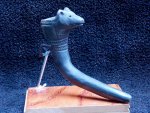
This is my favorite pipe form. All my fired pipes are smokable and just like what was used anciently. I borrow all my designs from pictures of actual artifacts. I've never lost a pipe in any of my firings.
The middle guy is what is called a "September Morn" figure.
Well see, you're the confused oneIt's actually a girl if you could have a different viewI'm guessing it had real human hair back when the Native Americans used it. Yes, I do certainly get some strange special orders.
Dave in KY
Shave Newbie
About now I'm sure a few of you are thinking about just how far down this "rabbit hole" I've gone. Well, it's a little bit deeper. All the flintknapping got me interested in the fur trade era of our American history. This was an interesting time because men were going west into Indian territories to trap primarily. They were marrying into Indian tribes, learning the languages and customs, and adopting many of the Indian beliefs, clothing, and ways of living. What this produced in the way of the equipment carried by these mountain men was very interesting. Here are a few of the things I've made from this era.
I absolutely love making pipe tomahawks. They were a much coveted trading item and not every Indian had one. The below pipe tomahawk now resides in the Murphy collection. I age the brass tacks and the shaft is curly maple. My pipe tomahawks are made correctly so they can be smoked if that's something that is desired. Most on the market lack the brain tanned deer leather gasket under the head to prevent smoke from leaking out all over the place around the head.
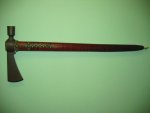
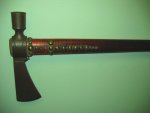
Here's what is called a spontoon. It was something the French brought down from Canada and traded with the Indians. I love this type of head. This one was in my personal collection until a PA collector talked me out of it. That's hard to do, but once in a while I find someone who loves it more than me and the price is right.
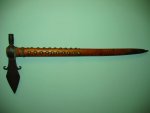
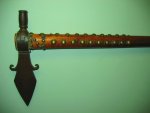
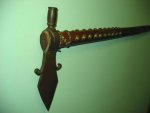
There's a fair amount of work that I put into my tomahawks. I age everything to the proper patina and even add the appropriate amount of "dirt" under the brass tacks so that they can hang on the wall and look convincingly old. I've also mounted a few authentic old heads onto new handles for customers and had to age things to match the head. I really like doing that. You have to think about how these things would have been used/abused and recreate use wear, scratches, gouges and other marks. While I don't forge my own heads yet, it's in the plans and is what got me interested in blacksmithing.
Here's a pipe tomahawk and knife that are in my personal collection. The shaft was made from a branch of ash that I burned the center hole out so that it could be used for smoking. I wanted it to replicate an Indian replacement shaft. The knife is a bear effigy fur trade era knife. I call these knives "The Convincers" because waving it around would pretty much convince anyone into agreement with whatever point you are trying to make as their hands cover their scalp. I actually have a "Convincer" like the one below left over from my last show that is made of curly ash and is beautiful. The blade is hand forged, but not by me.
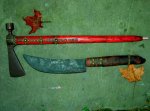
I absolutely love making pipe tomahawks. They were a much coveted trading item and not every Indian had one. The below pipe tomahawk now resides in the Murphy collection. I age the brass tacks and the shaft is curly maple. My pipe tomahawks are made correctly so they can be smoked if that's something that is desired. Most on the market lack the brain tanned deer leather gasket under the head to prevent smoke from leaking out all over the place around the head.


Here's what is called a spontoon. It was something the French brought down from Canada and traded with the Indians. I love this type of head. This one was in my personal collection until a PA collector talked me out of it. That's hard to do, but once in a while I find someone who loves it more than me and the price is right.



There's a fair amount of work that I put into my tomahawks. I age everything to the proper patina and even add the appropriate amount of "dirt" under the brass tacks so that they can hang on the wall and look convincingly old. I've also mounted a few authentic old heads onto new handles for customers and had to age things to match the head. I really like doing that. You have to think about how these things would have been used/abused and recreate use wear, scratches, gouges and other marks. While I don't forge my own heads yet, it's in the plans and is what got me interested in blacksmithing.
Here's a pipe tomahawk and knife that are in my personal collection. The shaft was made from a branch of ash that I burned the center hole out so that it could be used for smoking. I wanted it to replicate an Indian replacement shaft. The knife is a bear effigy fur trade era knife. I call these knives "The Convincers" because waving it around would pretty much convince anyone into agreement with whatever point you are trying to make as their hands cover their scalp. I actually have a "Convincer" like the one below left over from my last show that is made of curly ash and is beautiful. The blade is hand forged, but not by me.

Sir you are one talented man. My goodness!
Thanks Chad. I was born a few centuries too late
Going to Mike’s house for the zombie apocalypse!
I'm afraid you'd get eaten before you made it from CA all the way out here

